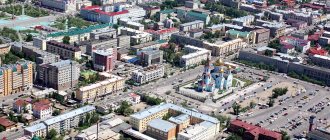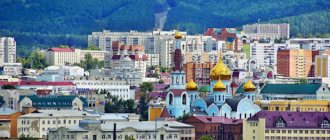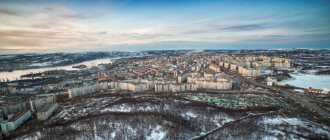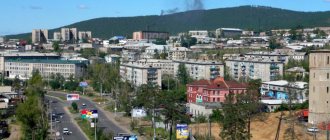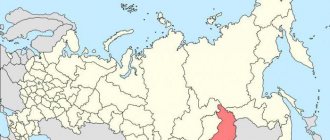The solemn date begins with the opening of events by the city administration. Congratulations are heard from the lips of the governor of the Trans-Baikal Territory. Flowers are laid at memorial sites. A street dance festival is held.
On this day, fans of extreme sports compete in driving vehicles and overcoming obstacles. Artists demonstrate their own works. Folk craftsmen show their crafts and share their accumulated experience.
Creative groups perform for citizens and guests. Children participate in games and competitions. Museums tell about the history of the locality.
In the evening, popular performers take to the stage. The concert ends with colorful fireworks.
The exact date of the celebration has not been established. By tradition, Chita City Day is celebrated on the last Saturday of May. In 2022 it falls on May 28th.
City information
Chita is the administrative center of the district of the same name and the Trans-Baikal Territory of the Russian Federation. Located in Eastern Siberia. The economy is represented by enterprises of the energy generating, mechanical engineering, and food industries. There are trading and service companies operating.
Near the settlement there are federal highways: P258, P297, A166. The line of the Trans-Siberian Railway runs through. There are vocational educational institutions, universities and their branches. The population is more than 330 thousand people. The ecological situation poses a danger to the environment.
Chita in the 21st century
Today Chita is a developed industrial city. The construction of objects of various importance has expanded, new foreign policy ties have been established, and trade is developing. Chita (the city’s population is especially proud of this) became the laureate of the prestigious national award “For worthy deeds - Grateful Russia”, the winner of the fourth All-Russian competition “Golden Ruble” in its district.
There are universities, schools, vocational guidance colleges, and research institutes in the city. Chita, whose population has the opportunity to raise its cultural level, has a sufficient number of educational institutions. There are 24 museums, theaters, a circus, a philharmonic society, and a large concert complex. Festivals and competitions of various levels are regularly organized and held.
Story
The history of Chita begins in 1653, with the founding of a winter hut by pioneer Pyotr Beketov, which laid the foundation for the village of Plotbishche. Later it was referred to as Chitinskaya Sloboda. Several dozen government employees lived there.
In 1711 it became a fort. In the second half of the 18th century, the settlement fell into decay. Since 1797, it was officially made a village belonging to the Gorodishchenskaya volost.
The year 1851 was marked by the acquisition of the status of the administrative center of the Transbaikal region. In 1897, the local branch of the Trans-Siberian Railway was put into operation. Soon the settlement acquired important transport significance.
Since 1918, Bolshevik power was established. Administrative affiliation changed many times. After World War II, the mining and engineering industries developed.
As part of the Russian Federation, the rate of economic growth has slowed down.
Religion
In 1776, on the site of a burnt wooden church in the Chita fort, the Archangel Michael Church, also wooden, was built. Until 1727, the parish was under the jurisdiction of the Tobolsk see, then it became part of the newly formed Irkutsk diocese.
In 1862, the Chita Missionary School was opened. On June 3, 1879, the center of the Selenga Vicariate of the Irkutsk Diocese was moved from the Posolky Transfiguration Monastery to Chita. In 1886, the Chita Intercession Monastery was founded. Since 1894, the city became the center of the independent Transbaikal and Nerchinsk diocese. In 1895, the Chita Diocesan Women's School was opened. In 1900, a religious school was transferred to Chita from Nerchinsk. From the same year, the Transbaikal Diocesan Gazette was published.
In 1911, there were 18 Orthodox churches, 4 chapels, a Roman Catholic Church in the name of St. Apostles Peter and Paul (since the 1870s), mosque, synagogue, Buddhist datsan (since 1899, burned down in 1914 under unclear circumstances). In 1913, construction of the Alexander Nevsky Cathedral was completed. In 1917, a Baptist meeting house was built.
On February 16, 1918, the Bolsheviks established themselves in the city and began to pursue their usual policy towards the Church. Having tried to seize the documents of the Ecclesiastical Consistory and having received an unequivocal refusal, they decided that “the local authorities could consider such an attitude of the clergy as the beginning of active actions against the existing government” [6]. The clergy who resisted the robbery of the consistory archive were arrested. On June 19, 1918, seeing no other way to help the imprisoned priests, the laity decided, trusting only in God’s help, to move to the prison with prayer in a procession of the cross. On the street Kamchatskaya had a police chain posted on her way to the prison. After the Orthodox Christians walking with banners and icons refused to stop, they opened fire. Several people were injured, and one of the participants in the procession was killed.
In 1922 - 1929, Chita was the center of the Transbaikal Renovation diocese. By 1924, not a single Orthodox church remained in the city. Subsequently, the department of the Orthodox Transbaikal diocese was located in the Kazan Cathedral, and after it was transferred in the spring of 1929 to supporters of the Gregorian schism, in the Archangel Michael Church. The late 1920s and early 1930s were marked by mass church closures. From March to November 1931, a trial was held in the city in the case of a “counter-revolutionary monarchist organization”, the head of which the OGPU identified Bishop Eusebius (Rozhdestvensky) (who was by that time Archbishop of Shadrinsk). 238 people were involved in the case. Many of them were shot, many were thrown into concentration camps or sent into exile. In 1936, the Alexander Nevsky Cathedral was blown up. Opened in 1945, the Chita Resurrection Church remained the only one operating on the territory of the current Chita diocese until the 1990s.
In the 1960s, the destruction of the Old Chita Cemetery began. In the 1970s, St. Andrew's Bishop's Church was destroyed, and the Archangel Michael Church on Kenon was destroyed.
Since 1994, Chita has been the cathedral city of the Chita and Transbaikal diocese. A significant event was the consecration of the new Kazan Cathedral in 2004.
Since 2002, the Roman Catholic parish of the Holy Apostles Peter and Paul has been operating in the city. In 2010, Chita became the second Russian city after St. Petersburg to open a Buddhist datsan.
On September 12, 2015, a monument to the Holy Blessed Grand Duke Alexander Nevsky was unveiled on the station square of the city.
Monasteries
- Pokrovsky (inactive)
- Uspensky (male)
Temples
- Alexander Nevsky Cathedral (exploded)
- Alexander Nevsky, chapel on Titovskaya Sopka
- Alexandra the Martyr, at the women's gymnasium (inactive)
- Andrew the First-Called, at the bishop's house (destroyed)
- Antonievsky, at the men's gymnasium (inactive)
- Presentation of the Most Holy Theotokos into the Temple, at the Diocesan Women's School (inactive)
- Resurrection of Christ
- All Saints
- St. George the Victorious, chapel
- Elijah the prophet, cemetery
- Innocent of Moscow
- Innocent of Irkutsk (?), at the missionary school (inactive)
- Kazan Icon of the Mother of God, Cathedral
- Luke Krymsky
- Michael the Archangel
- Michael the Archangel, on Kenon (inactive)
- Nicholas the Wonderworker
- Nicholas the Wonderworker, in Peschanka
- Nicholas the Wonderworker, at the vocational school (inactive)
- Peter and Paul, at the bishop's house (inactive)
- Transfiguration of the Lord
- Transfiguration of the Lord, prison (inactive)
- Nativity of John the Baptist, at st. Chita I
- Sergius of Radonezh
- Our Lady of Sorrows, cemetery (inactive)
- Saint Terenty, camp (inactive)
- Three Saints, at the teachers' seminary (inactive)
- Trinity Life-Giving, on the Island (inactive)
Coat of arms
The coat of arms of Chita is presented in the form of a French shield.
An eight-pointed scarlet and green palisade is depicted on a golden background. It points to the border with Mongolia and China. Above is a red buffalo head with silver eyes and tongue. It symbolizes agriculture.
The shield is topped with a gold tower crown with five teeth, surrounded by a gold laurel wreath on the hoop and entwined with a ribbon of the Order of the October Revolution (bottom and sides).
The artistic composition was adopted by the decision of the Duma of the city district. Chita" No. 177 dated November 15, 2007.
Famous people[edit]
- Alexandra Samusenko (1922–1945), Soviet tank captain, the only tanker of the 1st Guards Tank Army.
- Evgeny Alkhimov (born 1977), Russian professional football player
- Oleg Lundstrem (1916–2005), Soviet and Russian jazz composer.
- Igor Mirnov (born 1984), Russian professional ice hockey player
- Ivan Nagibin (born 1986), Russian professional football player
- Lev Okhotin (1911–1948), member of the Supreme Council of the Russian Fascist Party.
- Alexander Perfilyev (1895–1973), Russian journalist, poet and writer.
- Anastasia Pivovarova (born 1990), Russian professional tennis player
- Boris Polevoy (1918–2002), Russian historian.
- Vladimir Shkidchenko (born 1948), Ukrainian military officer, general of the Ukrainian Army.
- Sergei Smirnov (born 1950), Russian intelligence officer.
- Anatoly Sobchak (1937–2000), Russian politician.
- Vitaly Solomin (1941–2002), Soviet and Russian actor, director and screenwriter.
- Yuri Solomin (born 1935), Soviet and Russian actor and director.
- Alina Stadnik (born 1991), Ukrainian wrestler
- Alexander Stranichkin (born 1955), Abkhazian politician
- Lyudmila Titova (born 1946), Russian speed skater.
- Dmitry Tymchuk (born 1972), Ukrainian military expert and blogger
- Emelyan Yaroslavsky (1878–1943), Russian revolutionary, Soviet politician, organizer of the Communist Party.
- Natalia Kuznetsova (born 1991), Russian professional bodybuilder, holder of world titles in armlifting, bench press and deadlift.
Flag
The flag of Chita is made in the form of a rectangular panel. The ratio of its sides is 2:3. It is divided into four elements. At the shaft there is a yellow isosceles triangle. It has a base that matches the width of the flag. Its height is equal to half the length of the canvas. The figure is adjacent to equal stripes (pali) of green, white and red. The last one is located at the bottom, the second one is in the center.
The artistic composition was approved on December 14, 2006 (decision No. 225).
General information
The city is located on the slopes of two ridges: Yablonovy and Chersky, at the confluence of the Chita River and Ingoda. Within Chita there is the Titovskaya Sopka mountain with a height of 946 meters, as well as Lake Kenon. The natural landscape is varied: from meadows and steppes to mountain taiga.
Chita is located in a zone of pronounced continental climate with little snow in winter and warm, humid summer. The distance from the capital of the Russian Federation, Moscow, is 5000 km.
Hymn
At the site of Chita's first date with the cool Ingoda, free Cossack legends sang our native city: In the river valleys, in the transparent blue On the slopes of the Chersky ridge... Preserve the greatness of Russia And prosper for centuries, Chita!
The ancestors founded the winter quarters, And the settlement was replaced by a fort, Along the Trans-Siberian Railway, Russia traveled to the east. The heroic spirit was extolled, And the power of the sovereign shield... Preserve the greatness of Russia And prosper for centuries, Chita!
For the benefit of the Motherland, the deeds of Vershi, talented people... Create, the capital of Transbaikalia, Siberia, pride and stronghold! A bold dream leads us to new victories through the elements: Preserve the greatness of Russia And prosper for centuries, Chita!
Literature
- Encyclopedic Dictionary. - St. Petersburg: Brockhaus and Efron Publishing House, 1904. - T. 40.
- Popov A.I. City of Chita. Description, guide and reference book. - Chita, 1907.
- All Chita and Transbaikalia: Trade and industrial directory. - Chita, 1923.
- Chita - 125. Recommendatory decree. lit. to the 125th anniversary of Chita as a regional center / Compiled by: G. N. Galkova, V. F. Balabanov, V. G. Maltseva. - Chita, 1976.
- Dvornichenko N. E. Guide to Chita. Sights, monuments and memorable places. - Irkutsk, 1981.
- Climate of Chita / Ed. Ts. A. Shver, I. A. Zilbershteina. - L., 1982.
- Kradin N.P. Russian wooden architecture. - M., 1988.
- Chita: general geographical map Scale 1:200,000. - Sverdlovsk, 1991.
- Cities of Siberia: Encyclopedia. - Novosibirsk, 1994.
- Nemerov V. Chita. Story. Memorable places. Fates. - Chita, 1994.
- Chita. City in time. — Chita, 2001.
- All Russia. Cities and towns: Encyclopedia. - M., 2001.
- Lobanov V. G. Old Chita. — Chita, 2001.
- Chita. 350 years. Atlas of the city. - Omsk, 2003.
- Chita region and Aginsky Buryat Autonomous Okrug: Atlas. - Novosibirsk, 2006.
Gasification of Chita: an expensive utopia or a real way to get away from smog
Social activist Evgeny Kornev has been working on the topic of gasification of the Trans-Baikal Territory for many years. He is confident that before the main gas supply, a huge amount of work needs to be done to gasify private houses - so that the gas monopolist has a sales market. In a conversation with Chita.Ru editor Andrei Kozlov, Kornev provides some economic calculations that demonstrate the complexity of the problem. The main stumbling block right now is the price of heating a house using gas. It's just twice as expensive as heating with coal or wood.
The following is an edited transcript from the January 12 Editorial Board.
Everything that happens in Transbaikalia and the city of Chita
Evgeny Kornev was born on January 7, 1971. In 1996 he graduated from the Chita State Pedagogical University, then from the Transbaikal Institute of Entrepreneurship. He worked as deputy head of the Housing and Public Utilities Department, head of the Center for Service, Maintenance and Sales of State Property of the Trans-Baikal Territory, and head of the Emergency Situation Center.
In 2022, Kornev organized single pickets on Lenin Square demanding that the regional government consider issues related to orphans. In 2022, he participated in a rally against the administration of Chita, and then submitted documents to the competition for the post of head of the same administration, but did not make it to the second stage of the competition, since he did not indicate his income. Now he is an individual entrepreneur. In 2022, he participated in additional elections of deputies to the Chita City Duma in the Vitimsky electoral district and additional elections of a deputy of the Legislative Assembly in district No. 1 “Oktyabrsky”.
Andrey Kozlov (A.K.)
: Today our guest is Evgeniy Gennadyevich Kornev, and we will talk about the implementation of the federal Clean Air program in Chita. We discussed this topic with Andrei Tomskikh and said that the measures that were implemented in 2022 with federal money in terms of air purification in Chita were the purchase of new trolleybuses and the closure of several boiler houses.
You can read the transcript of the conversation here.
In terms of boiler houses, everything is clear, but most of the money went to new trolleybuses. This does not change the situation in any way with the state of the air in Chita. And Tomsky’s thoughts on this matter were confirmed partly indirectly by Federal Deputy Prime Minister Abramchenko, who listed the cities that achieved some quantifiable indicators for improving air quality in 2022 thanks to the implementation of this national project “Ecology”. Unfortunately, Chita was not there.
Everything that happens in Transbaikalia and the city of Chita
What does Kornev have to do with clean air issues? He is one of those people who are promoting a very specific gasification project in the Trans-Baikal Territory. Moreover, we are talking about a slightly different gasification. Not that mythical gasification, when some magic pipe comes, Gazprom will supposedly carry it out, which I don’t believe at all, and after that something magical will happen, the air will become clean, somehow the TGK-14 thermal power plant will be switched to gas.
The Russian government allocated 1.26 billion rubles to Chita for the implementation of the federal project “Clean Air” of the national program “Ecology”. The money will be used to reduce emissions of harmful substances into the atmosphere, including through the construction of a trolleybus line to the village of Kashtak, the purchase of 36 new trolleybuses, and the demolition of three boiler houses. All activities are planned to be completed in December 2022. The regional authorities plan to close seven more boiler houses and achieve gasification of the city. This will require 9 billion rubles; there is no source of financing for these ideas yet.
And we are talking about a very specific gasification of households, and this, in particular, before the New Year, Minister of Natural Resources Nemkov spoke about during a meeting in the City Duma. He spoke numbers that appear in many documents prepared, including by Kornev, as far as I understand. The point is that in Chita the main volume of air pollution is not caused by TGK-14 or even road transport, as they constantly say.
According to various estimates, the pollution of almost 74% of the air in Chita comes from private households, that is, ordinary houses with stove heating. According to various estimates, there are from 12 to 13 thousand of these houses within the city of Chita and about 10 thousand in the immediate vicinity, in particular, in the area of the village of Smolenka, which has grown very much. Dobrotny is nearby, and there are still a lot of dacha cooperatives. Everyone who traveled in that direction in winter clearly sees that this smog comes from the direction of Smolenka and combines with the smog that covers almost all of Chita.
Everything that happens in Transbaikalia and the city of Chita
And if in summer there is practically no problem of smog in Chita, then in winter we are plunged into this huge cloud. We sit under a blanket of smoke and smog, and it is private homes that provide this. Of course, cars also contribute to air pollution in Chita, but only about 5% of the pollution.
Well, naturally, TGK-14 also produces some kind of pollution, it cannot help but produce it, because it has a key CHPP-1 in Chita, which runs on coal. But it is still built wisely, taking into account the wind rose; there are some systems that carry out cleaning before this smoke gets into the air. TGC-14 has approximately 15% of air pollution in Chita and all other boiler houses - 10%.
I would like to discuss with Evgeniy Gennadievich how effective the measures that are currently being taken are and what really needs to be done.
Evgeniy Kornev (E.K.)
: In fact, we must first agree with your assessments with only a small difference, because, according to various estimates, we have from 15 to 21% - these are emissions generated by TGK-14, boiler houses, indeed, about 10% and road transport – 4.9%. If we calculate from here our cars that exist today, minibuses, instead of which trolleybuses and buses will travel, we will get somewhere around 0.01 - pollution will decrease by this percentage when installing a trolleybus line.
A.K.:
Do you also confirm the Tomskys’ thesis that the introduction of a new trolleybus line will not change anything?
E.K.:
Of course not. This is one of the measures, even half measures. It's minimum. We talk about everything, and now we are trying to somehow treat the disease. And, you know, this reminds me of an anecdote. A sick man came to the doctor. He says it hurts everywhere. It hurts here, here and here. The doctor says your finger is broken - no matter where you poke it, it hurts.
Therefore, in this case, the set of measures of the Clean Air program is currently not sufficiently administered; it is not administered at all in principle. The Clean Air program is, of course, a completely utopian product, which, within the framework of our proposals, must change completely radically. The approach must change completely, the content of this “Clean Air” program and, most importantly, the implementation methodology, so that there is no this authoritarian moment when we did not change the horde, but adopted its tools.
A.K.:
This is not authoritarianism, in my opinion. It seems to me that this is simply a lack of understanding of where to go. Now we are talking about the fact that there is a certain national project “Ecology”, within the framework of which there is a program “Clean Air”, you just need to use the money. “They will give us money, let’s spend it on something. “What can we really spend it on,” people in the government are thinking.
They say: “Listen, we can’t switch all houses to gas now, let’s come up with something that can actually be implemented.” I guess that's what they say. “Well, let’s replace the trolleybuses.” And they change.
Everything that happens in Transbaikalia and the city of Chita
E.K.:
"Let's do something." Well, it is. So in this part we need to do the analysis first. We don’t even have to reinvent the wheel – the analysis has been carried out, we have a lot of research work, there are developments from our former CHIPR, there is the “Great Research” project. All the points are given quite clearly there, they vary to one degree or another, but there is one conclusion, it is absolutely obvious: the private sector, firewood, coal - this is what is our main problem.
Therefore, everything else, these hidden moments, is a conversation in favor of the poor. Therefore, today we need to solve the main problem. Start with her. I will not give all the aspects regarding the methodology for solving this problem - there are quite a lot of them. They say, let's try electricity, let's lower tariffs, let's try this and that. Imagine for a second that now we have all started heating ourselves with cool electric boilers that consume almost nothing. Will the networks survive? They won't stand it. That is, we need to completely transfer all electrical networks, because this is a load.
Subsidizing the cost of electricity for heating private houses as an alternative to stove and coal heating was proposed by social activist Maxim Rezvikh in early January, at the same time he called the air on the streets of Chita a gas chamber.
A.K.:
Well, and produce much more power.
E.K.:
Naturally, that is, this is a real utopia. If we start talking about biofuels, they also have their own difficulties. Therefore, in terms of the most optimal approach, which can be differentiated from Russia, this, of course, is what is inherent to us, these are our hydrocarbons that lie underground. This gas is certainly a blue fuel that can be produced and used.
Gas has different types: propane-butane, methane, biofuel. And today, not only the domestic supply of gas and methane is carried out - this gas is supplied in huge volumes abroad. Therefore, of course, we should think in this direction. It is definitely in the direction of gasification.
A.K.:
Let us immediately understand at this point what kind of gasification we are talking about. Because no one can answer. What is meant? Will the pipe come here, or will we start transporting more liquefied gas here? What are we talking about?
E.K.:
There are two aspects to this. The first aspect is the type of gas. That is, residential buildings can be gasified with propane-butane and methane.
A.K.:
That is, it is necessary to change the heating of houses so that there are no stoves, but gas.
E.K.:
Gas boilers.
A.K.:
For example, there is a house, there is a Russian stove in which coal is burned or firewood is burned, and sometimes plastic. As I understand it, the point of operation of this stove is that during combustion, heat is generated, which heats the walls of the stove, and this heat spreads throughout the house. When we gasify this house, we remove the stove, install a boiler and extend hot water pipes throughout the house. This is the logic?
Everything that happens in Transbaikalia and the city of Chita
E.K.:
Here, between them, you need to show one more thing, the so-called boiler, that is, instead of a stove, there is a heating element inside that heats the water, which is distributed through the pipes, and you also heat it all with coal or wood, that is, an ordinary solid fuel boiler with a water heating system . And gas is used here instead of solid fuel, heating occurs with the help of gas.
A.K.:
That is, you say, there is a house with a Russian stove, and there is a house where there is a solid fuel boiler, which already has heat running through the pipes. And it is necessary, conditionally, to simply replace coal with gas, and in the house where there is a Russian stove, also lay all these communications?
E.K.:
Exactly. There are two types of fuel: propane-butane and methane, which we use for heating here today. The difference between these gases is quite significant, it begins with its origin, because propane-butane is a gas that appears by cracking oil, that is, distillation, roughly speaking. This is the highest form of distillation, that is, this gas is obtained from oil. Accordingly, its freezing point is minus 0.5 degrees Celsius. Therefore, there is a problem for us here. But in terms of its compression, delivery, and transportation, it is much better than methane. Methane is a natural, pipeline, associated, swamp gas that is located underground.
Basically, in the gasified part of Russia, methane is used, which goes through a pipe. If you compare propane-butane gas and methane, it is 8 thousand kilocalories and 11 thousand kilocalories, that is, propane-butane is much fattier, smaller in volume, but methane is more airy, one cubic meter of it gives 8000 kilocalories, this is its efficiency. So, in liquefied form it is a perishable product. It can be delivered either in a pipe or in special double-circuit barrels so that it does not heat up. He could be there for a week.
That is, if you brought a large volume, you need to distribute it to gas tanks very quickly, because otherwise it will begin to expand and will need to be vented. Its storage is carried out by two methods: compression to 300 atmospheres in special cylinders (this is very expensive), or cooling it to 167 degrees, it is compressed 630 times, becomes liquid, and in this state it also does not last long. Therefore, it turns out that as soon as we deliver this gas here, we need to put it somewhere. Tell me where will he go? We don’t have networks, we don’t have gas distribution networks at all, in principle.
A.K.:
That is, a pipe will arrive, and what should we do next with this pipe? That is, this gas needs to be put somewhere. But at the moment we are not talking about the pipe at all. I don't believe in her.
Everything that happens in Transbaikalia and the city of Chita
E.K.:
How can we talk about it? It has its own gas technologies, it must have a certain filling, and this is simply technically impossible without gas distribution networks.
A.K.:
That is, you are saying: at the current moment, it is logical to bring propane-butane gas here in barrels to ready-made consumers, relatively speaking?
E.K.:
Well, this is what is happening, as a matter of fact. Today, according to our calculations, we have about 60 houses, and the company that works in this direction has probably already connected 200–300 houses. The following happens: there is a cottage community, a gas holder is made for it, that is, a barrel is buried, propane-butane networks are installed to the houses. This boiler heats the water, supplies heat through pipes, and the system distributes it.
Just imagine, the propane-butane aspect is implemented on the territory of one cottage, the same can be done on the territory of another cottage, the same can be done on the territory of another cottage.
But now in general: what difference does it make for Gazprom that we did this? What has changed for them? Yes, nothing has changed. Yesterday there was a Russian stove, we equipped it with water heating, tomorrow we installed a solid fuel boiler, equipped it with water heating, the day after tomorrow we installed a gas boiler and our own gas holder. And what? Should Gazprom take this and bring it all to the cottage, transport it by car or do something else? There is no network. There is no gas distribution network, no real network that runs through the center of the village.
And here the problem is just technological, because the gas freezes. Let’s say that in the Krasnoyarsk Territory, with high snow cover and very shallow freezing depth, they can bury these nets at a depth of one and a half meters. Here we need to reach up to 4 meters to protect the gas from freezing.
Have you paid attention to gas tanks near five-story buildings? Their residents use gas for cooking. If you put a boiler room in place of the gas tank and run a pipe with an already heated coolant (antifreeze, water), here you will see huge losses in efficiency, because gas is very expensive and there is a loss of efficiency when delivering this heat. And the boiler that you install in each apartment will have a higher efficiency.
Everything that happens in Transbaikalia and the city of Chita
So, the fundamental difference is that our project, which I propose and the author of the patented system, Said Salikhovich Sharafutdinov (this is a group), is a technical expert, ideologist, inventor of this project. So, the project has a fundamental difference in that we are starting to build networks not for propane-butane. They carry propane-butane. And we, just like Zabautongaz, are doing this gasification, and today people receive imported propane-butane for now, temporarily. But the network itself provides for the possibility that methane can flow through it simply by turning a toggle switch. That's all.
According to the Kontur.Focus service, at the end of 2022, the registration authority decided to impending exclusion of a legal entity - Limited Liability Company "Regiongasservice" - from the Unified State Register of Legal Entities, since a record of unreliability was made in relation to the legal entity. The CEO is Said Sharafutdinov, he also owns 90% of the company.
In January 2022, Sharafutdinov presented Chita.Ru with a gasification plan for the Trans-Baikal Territory, which does not require funds as significant as for the Clean Air program, but radically and irrevocably solves many problems of the city and the region as a whole: from ecology to social growth and stabilization of the demographic situation in the region.
That is, roughly speaking, we are preparing network gasification in advance. After all, as we found out, why don’t we have a pipe? Because there are no gas distribution networks. Answer me this question: why are there no gas distribution networks? Because there is no pipe. And thus we cut this knot of Damocles. We are making networks, and for the time being, from the point of view of our schedule, all the provided calculations, while these houses begin to switch to this gas, the network itself then does not need to be switched. There are other technologies. The network itself must change. If the network is propane-butane, and methane is added there, it will not burn.
If we continue gasification in the way that today, from the government’s point of view, has been left to chance, we, strictly speaking, in 5–10 years will find ourselves in the same position as now. Because the same Gazprom will come, see a bunch of cottages connected to this propane-butane and understand that it is necessary to completely switch all networks to methane and do everything all over again. Our project and the project that we propose to the government provide for the construction of methane networks.
A.K.:
I see, you're suggesting. What does the government say?
E.K.:
This is the most difficult question. Did you first ask where it came from? So, in itself, my departure from the state government institution “Center for State Property” is connected precisely with this. That is, this project appeared as a consequence, as a chain of these things. In 2016, when my colleagues and I assessed the housing that we bought for orphans on the secondary market, I immediately came to Governor Zhdanova and said: “This is just a disaster.” You know this story, we won’t talk about it now.
And we immediately proposed building new housing using normal technologies. And the most important aspect here was the development of competition. And then project management was created, because the implementation mechanism was the most important thing at that time. And this project management provided for complex development. Vasily Petrovich Borodin, the famous former first deputy mayor for a long time, brought this project.
We did a comprehensive development of the projects for the Vitimsky, Amursky, Romanovsky, Preobrazhensky microdistricts, we calculated everything. Then there was the Housing program, we could receive subsidies and so on. That is, everything was ready and they even spent about 300 thousand on the projects of these houses. And at that moment Said Salekhovich appeared. He came and said: “Listen, what do you want here?” We have 800 million allocated for the booster pipe of TGK-14. She was just in the first comprehensive plan for Clean Air. This was a connection from a point in front of Kashtak, there is a thermal unit.
Everything that happens in Transbaikalia and the city of Chita
We envisaged the construction of this pipe about 4.5 kilometers, just in the microdistricts of Amursky, Romanovsky, Vitimsky, Preobrazhensky, in order to provide centralized heating there. And then he calculated these 800 million, and at that time, especially taking into account the cost of gas, we had an alternative that we could gasify through this pipe.
A.K.:
That is, you were talking about the need to build houses and immediately provide gas heating?
E.K.:
Exactly. Back in 2016.
A.K.:
Nemkov is talking about the private sector, 12 thousand households, these are your numbers, among other things. And he says: “If we consider electrification, replacing boilers with electric ones, then 9 billion rubles are needed. Switching to thermal power plants (generally a fabulous amount) - about 35 billion rubles. The only way out is gas. Switching to gas, according to estimates, amounts to only 4 billion rubles, which is 350 thousand rubles per household.” That is, he takes 12 thousand households, rounds them up very much and multiplies them by 350 thousand rubles and gets 4.2 billion rubles.
I don’t really understand what Nemkov means. He still means replacing solid fuel boilers with gas boilers and replacing Russian stoves with an entire system. He talks about 350 thousand rubles per household, which should be paid by who – the state?
E.K.:
Here, let's look at the numbers first. Nemkov is right, but he is right only in part of this narrow figure, which is per house and which we also counted. The figure is approximately comparable. The entire project that we sent to Gazprom for evaluation actually included 7.5 billion rubles. What was included?
Firstly, 400 thousand for 12,861 houses, which is already 5.2 billion rubles. Secondly, 500 million rubles in order to create a fleet of vehicles - to deliver this gas to people, and then for technological maintenance and maintenance. One and a half billion rubles were provided for the construction of technology parks, four of them were envisaged. The technopark consists of tanks, gas tanks are repaired, everything is stored and serviced there.
A.K.:
And let's rise even higher: do we bring gas by rail?
E.K.:
It can be brought by rail, it can be brought by cars.
Everything that happens in Transbaikalia and the city of Chita
A.K.:
Well, perhaps it’s better by rail?
E.K.:
Undoubtedly. Cheaper. Well, volumes. And it turns out to be more than 7 billion rubles. There is the narrowest part, which is a big expense - these are 8-10 mm gas holder barrels. They must change after certain periods of time. It's dangerous if you don't watch this barrel. So, Said Salekhovich and I then thought: in order to reduce the cost of producing these barrels, we could very well start making them at the Sretensky Shipbuilding Plant, because there are two workshops there, and all the equipment is specifically designed for the production of these gas tanks.
So, it was envisaged that Gazprom would give us 7.2 billion rubles, comparable figures, for gasification. That is, we give a person 400 thousand, he receives full gas supply on a turnkey basis, and we build a network. We won’t go into the elements of ownership and who will manage what there now, but within the framework of this federal program, with certain co-financing, we could go there, because we were creating a sales market for Gazprom, a new consumer, and, in fact, political dividends.
A.K.:
So you are saying that Gazprom, within the framework of some kind of private-state concession, can invest 7.5 billion rubles in converting these houses to gas, in creating the entire gas infrastructure and then, relatively speaking, receive money from this sales market?
E.K.:
With one amendment: not quite all of Gazprom, there are investors there, this is an investment project. There is co-financing from the state, there is co-financing from private investors themselves. In particular, we were ready to enter this program. And the most important thing is the technological opportunity, because the patented system that our company has today is unique, and it allows you to build networks at low depths. I won't reveal these secrets for now.
A.K.:
Fine. That is, conditionally, these 12 thousand households are given by the state or the investor to convert their houses to gas. So they then have to pay for this gas. How much does it cost to heat a house in winter?
E.K.:
Here is a small disclaimer: today we connect houses, and people pay themselves. They are ready to incur these costs because they understand perfectly well that they will have to wait for the state until the third coming, especially within the framework of the management system in the Trans-Baikal Territory. Now the moment is why people are not so actively involved in these processes? Because gas, for example, has tripled in price during this year. Imagine an average cottage, let's take 100 square meters. For heating in winter, it was necessary to spend between 7-8 thousand rubles per month.
Everything that happens in Transbaikalia and the city of Chita
Now imagine the costs of a large boiler house that serves an entire village. For some reason, only firewood is counted, and no one talks about what is associated with the maintenance of stokers and the cost increases by 30%. You multiply it all. Today, the average cottage will cost 18 thousand in winter and 7–8 thousand in autumn.
A.K.:
Do you understand that this is a dead end? Nobody will pay you that much money. This problem appeared in 2022, when the price of gas almost doubled. That is, in order to convince people to switch their homes to gas, by and large, this payment needs to be subsidized.
E.K.:
Law 69 provides for the government's ability and even the government's responsibility to set a price for gas that will be comparable to alternative sources of heat supply.
As a former deputy head of a unified cash settlement center in ancient times, I understand perfectly well that the point associated with this subsidy, its technology, is a targeted subsidy. That is, it is best to subsidize on the basis of the documents provided for an individual household. But that's not even the point here. Today we understand that the government will not do this either; it seems to have turned its back on the people today and is going its own way.
A.K.:
To the trolleybuses.
Application consideration period
The decision to assign or refuse to assign a monthly payment is made by the authorized body within 10 working days
from the date of receipt of the application.
However, this period is suspended and can be extended up to 20 working days in the event of failure to receive information requested as part of interdepartmental interaction.
Information from the Ministry of Labor
Official portal Zabaykalsky Krai
As part of the regional project “Financial support for families at the birth of children” of the national project “Demography”, Transbaikal families in which a third or subsequent child was born after December 31, 2022 are entitled to a monthly cash payment. The benefit is paid for each child from January 1, 2022 until the child reaches the age of three years. The regional Ministry of Labor and Social Protection of the Population spoke in detail about this support measure.
The monthly cash payment this year is 14,199.22 rubles. Families whose average per capita income does not exceed twice the subsistence level of the working-age population are entitled to this payment.
Thus, one of the parents or another legal representative of the child, who is a citizen of the Russian Federation and lives in Transbaikalia, if the average per capita family income does not exceed 27,817.78 rubles per month for each family member, has the right to receive financial support.
Payment this year is made from the date of birth (adoption) of the third child or subsequent children, but not earlier than January 1, 2021, if the application was made no later than the end of 2021.
Trans-Baikal families can submit an application for a monthly cash payment to the social protection department at their place of residence, through the MFC branch or by post, in a way that allows them to confirm the fact and date of departure.
To confirm the right to this measure of support, recipients annually submit documents to the social security department to assign payments, after one year from the date of registration of these documents.
Residents of the region can learn more about all social support measures on the website of the regional social protection center.
Press service of the Ministry of Labor and Social Protection of the Population of the Trans-Baikal Territory, Daria Dodonova
Source

